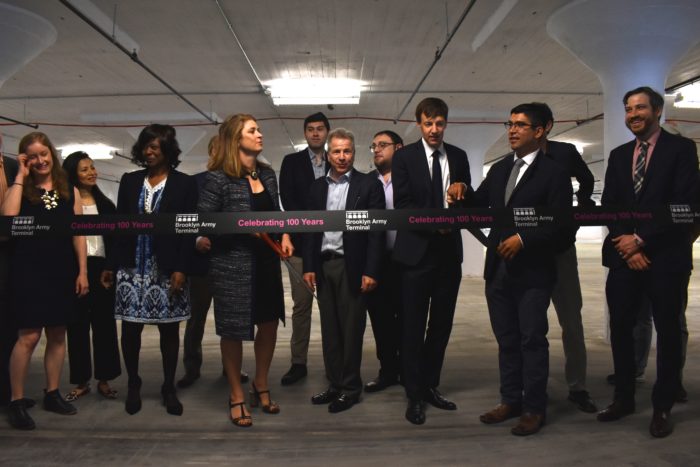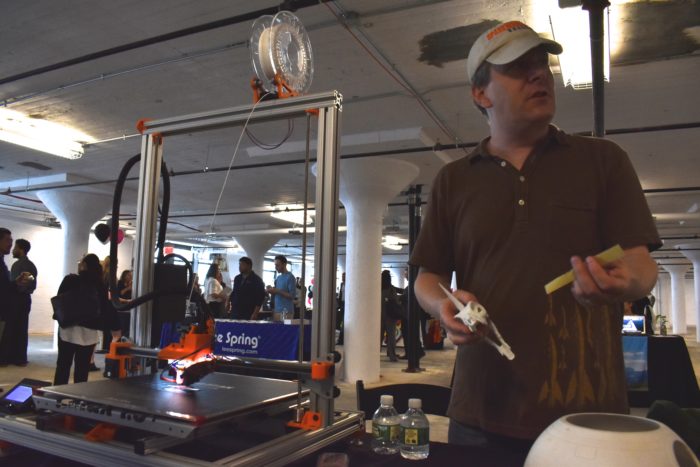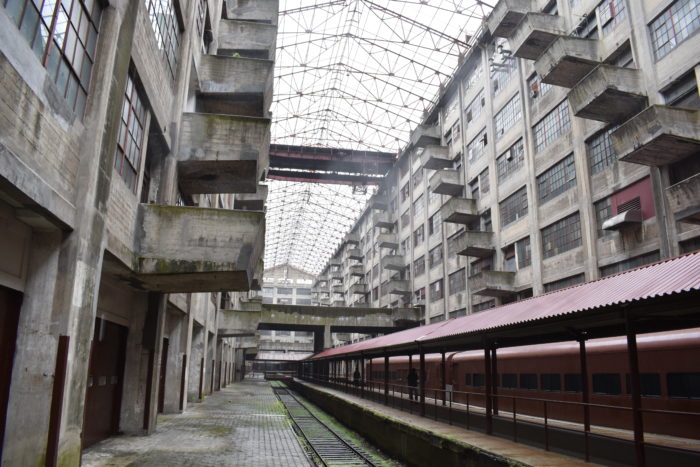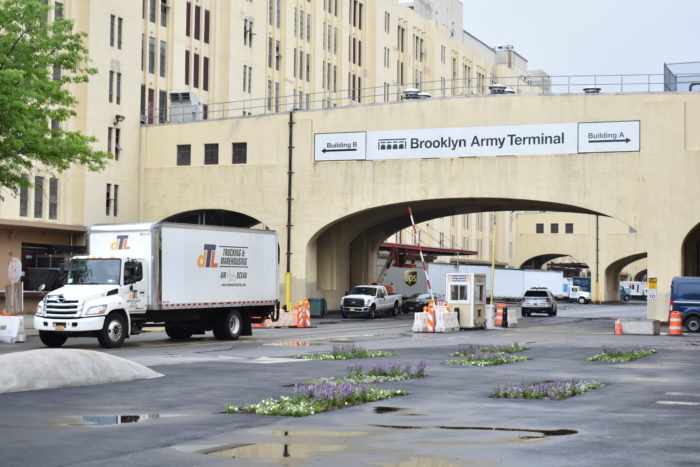A Peek Inside the Bustling Brooklyn Army Terminal
Celebrating its 100th birthday, the BAT unveils new space for 20 companies and big plans for growth
Public officials cut a ribbon to celebrate the opening of half a million square feet of new space (Photos by Graison Dangor)
When work on the Brooklyn Army Terminal (BAT) began in 1918, it was designed to be quickly turned over to the private sector once World War I ended. It took a little longer than that–the first manufacturing tenants arrived in 1987.
Now comes another milestone for the 4 million-sq.-ft. complex in Sunset Park. For the terminal’s 100th birthday, the New York City Economic Development Corp. (NYCEDC), which manages the property, announced last week that it had created more than 500,000 sq. ft. of new industrial space that will make room for more than 1,000 new jobs.

Council Member Menchaca chats with representatives of The Konery, which makes its products in the terminal
“That’s a lot of jobs in a place that people had fundamentally written off,” said Alicia Glen, the city’s deputy mayor for housing and economic development. The announcement also welcomed new tenants, unveiled improved public space, and announced new efforts to position BAT as an innovative industrial campus.
The de Blasio Administration has committed more than $200 million to transform BAT to help further the goals of his New York Works plan to create good-paying, accessible jobs. The new space is designed for up to 20 companies.

Gary Oshust, owner of SPark Workshop Brooklyn, will be moving his facility into BAT from Industry City
Among the new tenants is Gary Oshust, who owns a membership studio space for artists, inventors, and other makers, to double his space and expand into metalwork. His company, SPark Workshop Brooklyn, will move to the BAT from its space in Industry City in September, Oshust said, when it will add new machines for its three dozen members to weld, mill, and lathe metal.
In its current space, the studio was not allowed to weld, he said, and it wasn’t large enough. “A lot of the people I’ve been turning away have been asking about metalwork,” he said. He plans to get in touch with prospective members who will now be able to use its new tools to build furniture or sculpt with metal.

Poursteady makes its pour-over coffee machines at BAT; they combine motion control with speed and reliability
Besides attracting new tenants, the expanded BAT will enable current ones to grow. Among them is Altronix, a leading U.S. designer and manufacturer of low-voltage power supplies, which has more than 250 employees at BAT.
Another is Jomashop, a luxury watch e-retailer with 170 employees, which will use the additional space partly for watch-repair work. “We love the energy and the positive vibe that the Brooklyn Army Terminal gives us. It’s a first-class facility, for both logistics and running our offices,” said Jomashop president Marvin Sternberg in a statement. Sternberg, a Brooklyn native, called the BAT’s rebirth “a true blessing.”

While the workspaces may be modern, the cavernous atrium of the BAT still evokes the hurried, no-frills concrete construction of the WWI era
The expanded BAT is certain to become a magnet for skilled talent from all over, but will it benefit its Sunset Park neighborhood? That’s a question that hovers over the city’s industrial-redevelopment efforts, especially here, where residents feel that opportunities may bypass them. The area has nearly 40% more people in poverty than the rest of the city and more than double the number of residents with limited proficiency in English.
Carlos Menchaca, the City Council member for Sunset Park, celebrated the BAT expansion but said his constituents are worried they won’t benefit from it. “There is so much concern that’s what’s happening on the waterfront is not for them,” he said.

Tours of the sprawling complex, with commentary on its history, are conducted by Turnstile Tours
One barrier to getting a job at the facility is language. Menchaca said people who don’t speak English “would never feel comfortable” walking into the city-run Workforce1 career center at BAT, which places people in jobs with corporate tenants. He and the EDC met recently with community groups to discuss all of the barriers and overcoming them. “The concern is real,” he said, “and we need to hit it straight on.” Last year, the Workforce1 center helped 349 residents get jobs with
BAT tenants and other Brooklyn-based businesses, according to the NYCEDC.
The de Blasio administration, for its part, is taking some steps to address the issue, including a new training-and-innovation platform called Launch Pad, which will connect local residents to modern industrial skills through workshops and other programs. In addition, Brooklyn-based home-furnishings retailer West Elm will support local entrepreneurs and emerging artists with scholarships to SPark Workshops and mentoring programs.
The administration also aims to make BAT more accessible to the general public as well, bringing new eateries and arts and community programming. BAT’s neighbor just up the road, Industry City, has already made itself a destination for shopping and entertainment. It looks like BAT could soon be a friendly rival.













